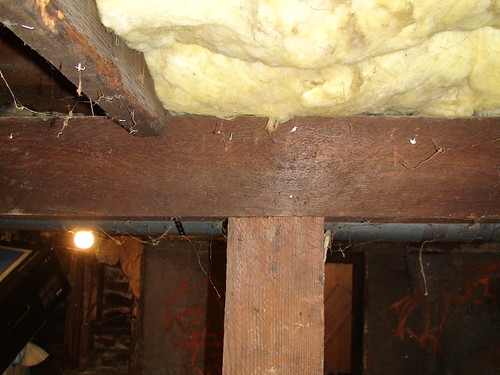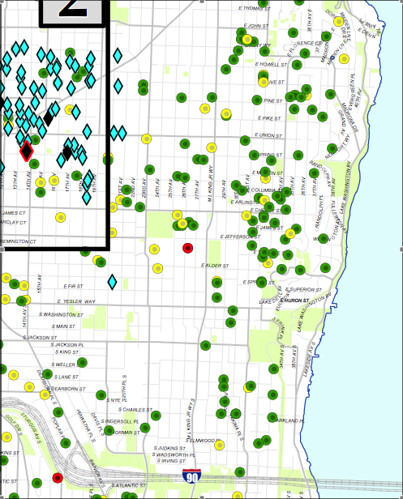
The earthquake in China is looking worse and worse. They’re saying the final death toll could reach 50,000-60,000.
And today the PI has a good story on our own local earthquake risk. The Seattle Fault is very similar to the one that produced the 7.9 quake in China, and it runs very close to the CD, just a bit south of I-90. And the risk maps put us in the upper range of possible damage, with a 2% chance that we’ll see an earthquake within 50 years that will exert forces of 60% higher than that of gravity.
Most houses here are old and were built before there was any kind of focus on seismic stability, so it seems like we could see major problems if there was a big quake. I guess our saving grace is that almost all of our buildings are wood-frame construction, which tends to fare much better than the masonry structures down in Pioneer Square.
My house is 107 years old. I was working in Pioneer Square during the Nisqually quake in 2001, and it was so bad down there that I rushed home, assuming that I’d find my house in a pile of rubble. The entire middle of my house is supported on 8 posts in the basement that are unconnected in any way to the ground or the rest of the structure, and I figured they’d be the first to go. But the shaking was much less here and the posts showed only the slightest signs of movement and otherwise there were only a few cracks in the drywall. But a shallow, more severe quake on the Seattle Fault would probably do much more damage.
So I’m curious how well prepared other folks in the neighborhood are. Have you gone to the expense of retrofitting your old house for earthquakes? I was told that would approach $30k, putting it out of my remodeling budget. And if there’s any structural engineers who have suggestions about what should be done to prepare us, please let us know your thoughts.


I’m not a structrual engineer (just electrical engineer) but looking at the picture of your basement post and beam it seems that you could at least do an affordable item that might help you some. Get some heavy duty T-brackets and screw the posts and beams together with them. This would at least help keep the beam and post together as one unit during shaking or up and down movement.
I imagine it is probably more involved to secure the base of the post to the floor (probably cement?) but again some metal L brackets could be screwed into the base of the post and drilled into the concrete with a concrete bit. Can’t imagine all of that costing more that a couple hundred bucks if you did the work yourself and probably only a day’s worth of work. If they are all exposed like in the picture it looks like they should be reasonably accessible as well.
The good news is that a 107 year old house has been through at least 3 significant earthquakes in Seattle (1949, 1963, and 2001) and has apparently held up so far. But you never do know what the next one will be like (deep or shallow, small or big, etc).
I keep emergency supplies on hand. “Expect the best but plan for the worst,” as they say. The P-I ran a great series of articles after the Nisqually quake, but people have an odd way of forgetting there’s any danger. “Can’t happen here.” In the 1700s a mega-quake lifted parts of Seattle by 10 feet.
So I keep food and water for 3-7 days per person (I add a little with every trip to the store). After Katrina, even FEMA recommends up to 7 days per person, with 3 of that ready-to-carry.
A hand-cranked weatherproof radio, camping gear (in case all the windows shatter and it’s winter), extra flash lights and glow sticks, etc. There are numerous lists and menus online for the paranoid, or former Boy Scouts like me. :-)
I have quake insurance with some awful deductible like 20%. I figure on one of two scenarios: broken windows and dishes that I’ll cover out of pocket, or total collapse/fire, in which case the insurance helps me sleep at night. I think people in Puget Sound who skip quake insurance to save a few hundred dollars are nuts.
My house is newer so other than strapping the water heater to the studs, I’ve left it alone. I really should strap the bookcases one of these weekends….
I was also going to take basic Red Cross training – it’s only $60/one day – but haven’t gotten to it yet. That whole sleepy comfort thing.
My CD home is one of the older wooden structures as well, and has at least partially been retro-fitted for earth quakes. The wooden substructure was bolted to the new cement foundations all the way around ( bolts were placed in the cement, and bolted to the new wooden sub-walls ), but I was informed of several additional items I could do myself. In the basement, I added wooden cross bracing to prevent the 2 x 6 walls ( between the cement foundation and the first floor ) from collapse. Basically, I added plywood sheets to join the 2 x 6 supports together ). I also added hot water tank straps to prevent these from falling over. Just keeping the hot water tank from falling over, hopefully keeps usable water in the tank and out of the walls and off floors. After this I was able to buy earth quake insurance, but dropped it a few years ago as it was way too expensive, and had an unbelievable deductible. Since I have a gas meter outside the house, I added a wrench to be able to turn off the gas if necessary, and placed small fire extinguishers around the house ( just to assist in a safe exit ).
A fellow EE major! Are you using your degree? I’m only using that 5% that we did software in school (and that was assembly, which isn’t too practical for internet applications).
I’ve thought about doing what you suggest, but was told that anything short of a complete retrofit would cause more problems than not. Evidently all the typical hardware store bracing would add stiffness, which was said to be counterproductive.
And to Cooper’s point below, older homes can’t even get quake insurance unless they get a complete retrofit.
I grew up in various parts of California except for a 2-year stint in Idaho. There has been at least one > 7.0 quake everywhere I have ever lived except here. So I generally keep some supplies on hand, and I suggest that all of my neighbors do so as well until my curse is fulfilled in Seattle :)
A few tips I remember well from California:
* During a big quake the safest place to be is under a large table away from sources of flying debris. Failing that, a doorway is the next best opttion. Don’t ever rush outside and stay away from inside structures like fireplaces that might collapse. More people die from building pieces falling on them than from buildings falling down around them.
* If you have natural gas, learn how to turn it off. Walk around your house after a quake (once it’s safe to do so) and turn your gas off if you smell a leak.
* If you have a water tank, fill your bathtubs immediately after the quake subsides. This provides a bunch of drinkable water to supplement what you have stored. If you wait, you’ll get contamination in your water from any broken water mains.
* If you have pets, don’t forgot to keep several days’ food on hand for them, too.
Our earthquake upgrades were just as mentioned above: T-shaped metal plates to bind beams together, straps and blots epoxyed into the basement floor, “hurricane ties” to join joists to the rest and plywood sheets to brace the “cripple walls” and sill plates bolted/epoxyed to basement wall.
Nothing too complex, but we didn’t do it. Happy to pay someone else to spend days drilling into concrete for all the bolts.
Did the water heater strapping myself: definitely a good source of lots of fresh water. 40 gallons would last a while. Camping supplies & equipment are a good backup.
http://www.seattle.gov/emergency/
This Saturday at Garfield CC anytime from 10-2. Tracy Connelly from the city’s SNAP program will be there at the beginning and end parts (they have the grand opening event for the Emergency Management Center that day) and I will be (wo)manning the table when she is gone.
We will have information on how to be prepared for yourself, family and pets, and making your home safe. It’s unlikely that first responders will be very available to everyone during a crisis. SNAP works with neighborhoods to develop community preparedness. What are the scenarios and needs? What are the skills in the neighborhood? Where are neighbors with special needs? Who are the people with training and skills? Do they have supplies stored in their homes? All within walking distance. How does the neighborhood coordinate with the rest of the area?
After the storms and outages two years ago, I found out a friend had gas to cook and I had gas to heat. She was freezing and I was hungry. Minor inconvenience, I know. But, it made me think that I’d like to go beyond the things I need to do personally like put latching doors on the bookcases and cabinets that I did strap to the studs.
So, where do I keep my supplies? Do I store them in the basement of our 100 year old home, in the pantry, in the cement bunker we call a garage, or have items in all 3 and our vehicles? I’ve seen all the lists about what to have on hand, but where is the safest place to store them in case there is a large earthquake?
Put them in watertight Rubbermaid containers. Ideally in two locations (the garage and the car).
Scott, yes I actually do use my EE degree, or at least did before the term manager crept into my title. I have worked as an engineer in semiconductors for almost 11 years now. But I now have the title of Program Manger for R&D projects, so questionable how much I use those skills anymore these days.
Totally agree that you need the full retrofit for insurance reasons. My 101 year old house is the first that I have not had earthquake insurance for because of the cost to benefit ratio. My house was renovated by previous owner in 2005 and reportedly secured to the foundation, but unfortunately there is not proof because the basement is completely finished and it would require opening the walls to verify. Even then, insurance was going to be quite pricey and really requires a lot of damage before it is worth making a claim.